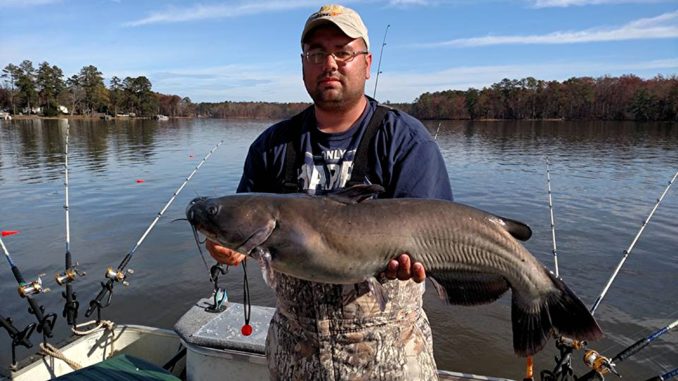
Use easily available information to get a head start on catching Lake Wylie’s burgeoning population of blue catfish. It’s right at your fingertips.
James Moore of Westminster, S.C., will readily admit that he doesn’t consider Lake Wylie as one of his home lakes, but every time he goes there, he does well catching blue catfish. One of the reasons he said he’s had better success than most is because the lake scouts well.
Moore said fishermen, at least the majority of catfish tournament anglers, have formed a strong bond, mostly facilitated through internet websites, and a lot of available information is available about Wylie — a Catawba River reservoir on the North Carolina-South Carolina border — as well as a lot of conservation-minded thinking about catfish in general.
“Starting into a new season, I will read up on everything Google’s got to offer, everything on the Brotherhood of Catfishermen, and the Catfish One website. I scout all that,” said Moore. “This year’s weather has been unusual, so I’m looking to see where things are in the whole cycle of catfishing on the lake.”
Moore’s scouting doesn’t stop at the internet. Once he has a feel for Wylie’s current pattern, he will double check that information on the map.
“I go to my Navionics web app and pull up the contours. I’ll sit on my couch at home and look for places where catfish are going to be transitioning from out on a deep ledge into a creek,” he said. “I have also logged everything about my trips for the past 5 years, so I can fill in the blanks with my logs.
“I keep a page per trip that includes every detail as far as moon phase, water clarity, wind speed and direction, all the different types of bait and the number of fish and the biggest fish caught per trip,” he said. “I’ve found that water temperature makes the biggest difference in my decision making.”
Moore has a primary plan and a backup plan anytime he goes out in pursuit of catfish, which are well known to constantly move in both Lake Wylie and other lakes.
“By late February through the month of March, the fish are going to be transitioning from the lower end of the lake up South Fork and the creeks on that end,” he said. “The fish are going to start transitioning to the back of those creeks and staging up at the mouth of the creeks. I look for bends with sharp ledges and points that come out right at the bend.”
Moore likens his primary plan to still-hunting for deer. He will arrive at the lake with three or four spots in mind, with the intent of fishing each one for an hour.
“I pick two good anchor spots that I feel confident in or look like they have potential. How well those spots do determine how I’ll spend the rest of my day. If I get on fish. I’ll mimic that same situation in every creek around until I quit catching fish,” he said.
Some days, Lake Wylie’s catfish may not agree with his locations for dining. On those occasions, we will go to his back-up plan: trolling ledges in the general areas he has identified.
Moore trolls using a basic Santee-style catfish drift rig. From heavy, 30- to 50-pound main line, he will attach a 1 ½-ounce slinky weight ahead of a barrel swivel. Behind the swivel is a 3-foot section of heavy fluorocarbon leader. On the terminal end is an 8/0 Mustad Demon Circle hook. A foot away from the hook is the customary 2-inch crappie float to keep the bait about a foot off the bottom and right in a passing catfish’s face.
“When I troll, I like to cover different depths, so I target ledges,” said Moore. “A ledge where the top of the ledge is 18 feet and it slopes off to 35 feet’s near perfect.”
Moore likes to cover as much water as possible using up to 10 rods at a time when trolling. He does that by placing three bait rigs on each side behind a planer board. He then runs four rods off the boat’s transom.
Using a planer board has its challenges, but is not as difficult as it might seem. The rule of thumb is to put out line behind the board at least two times the maximum depth he’ll be fishing. This amount of scope, combined with a relatively light weight, keeps the rig from snagging and fouling.
“I pull an ounce to ounce-and-a-half of weight, max,” he said. “If I think there’s going to be an issue where the bottom drops off to 40 or 50 feet, I let out just a lot more line just to make sure the rig gets to the bottom.”
Moore said the potential for catching trophy cats at Wylie is high, due in large part to the efforts put forth there by dedicated catfish anglers to catch-and-release all big catfish.
“I’ve been following the Catfish One website for nearly 10 years now,” said Moore. “Before then, I had never heard of letting a catfish go. I grew up fishing at Santee, where we would hang one on every nail on the board for our pictures.”
Moore said his mind, and his philosophy in general, changed from a ‘fill-the-freezer” mentality to one of targeting and releasing trophy sized catfish.
“I started seeing guys talking about CPR and I thought, ‘What the heck does that mean?’ Once I realized that it was ‘Catch, Photo, and Release,’ I realized what they were doing and the reason behind it, it made perfect sense to me and it has changed the way I catfish,” he said.
“I have two small children and what would mean the most to me is letting them have a chance to enjoy this fishery for years to come.”
DESTINATION INFORMATION
HOW TO GET THERE — Lake Wylie is on the Catawba River, along the border between North Carolina and South Carolina southwest of Charlotte and north of Rock Hill. It’s easily accessed from I-77 and NC 49, with the public ramp at Buster Boyd Bridge at mid-lake providing excellent access to both ends of the 13,443-acre lake. Additional public access areas can be found at www.ncwildlife.org/Portals/O/Fishing/Documents/Piedmont_Region_Fishing_Guide.pdf; and dnr.sc.gov/lakes/wylie/description.html.
BEST TECHNIQUES — Catfish are in transition on Lake Wylie in March, moving from the deeper areas on the lower end of the lake to creek-channels and flats. Before a trip, use a good topo map or internet sources such as Google Earth to locate creek bends or other areas where steep drop-off transition from shallow water to deep. Plan on fishing a handful of those areas using cut white perch, anchoring up and fan-casting your baits in a variety of depths. If anchoring up is not producing, use the wind of a trolling motor to troll drift rigs in likely areas to locate roaming schools of catfish.
FISHING INFO/GUIDES — Jerry Neeley, Jerry’s Fishing Guide Service, 704-678-1043, www.carolinasfishing.com; Rodger Taylor, Catfish On Guide Service, 803-328-9587, www.catfishon.com. See also Guides and Charters in Classifieds.
ACCOMMODATIONS — Lake Wylie Chamber of Commerce, 803-831-2827, www.lakewyliesc.com; Gaston Regional Chamber of Commerce, 704-864-2621; www.gastonchamber.com.
MAPS — Navionics Electronic Charts, www.navionics.com; Delorme’s South Carolina Atlas & Gazetteer, North Carolina Atlas & Gazetteer, 800-561-5105; www.delorme.com; Fishing Hot Spots, 800-ALLMAPS, www.fishinghotspots.com; Kingfisher Maps, 800-326-0257, www.kfmaps.com.
BEFORE YOU GO — North Carolina and South Carolina do not have a reciprocal license agreement. To fish the entire lake, you must have licenses from both states. Contact these state agencies for license information: S.C. Department of Natural Resources, 866-714-3611, www.dnr.sc.gov/purchase.html; N.C. Wildlife Resources Commission, 888-2HUNTFISH, www.ncwildlife.org/fs_Purchase_License.html.

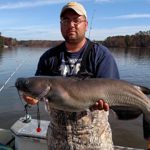
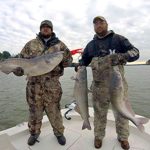
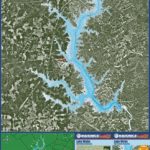
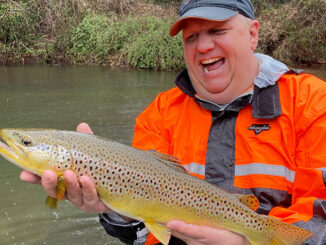



Be the first to comment